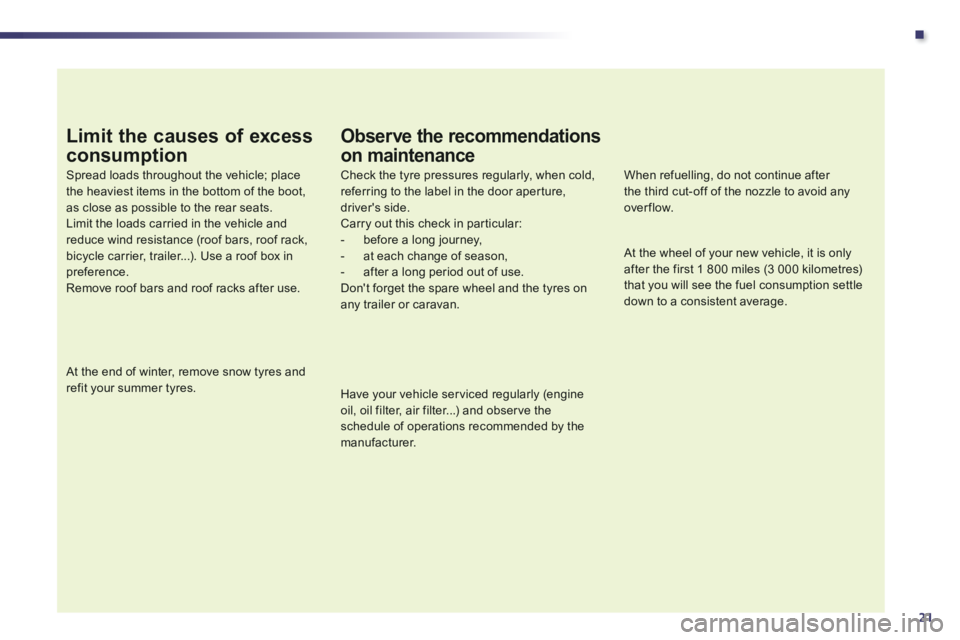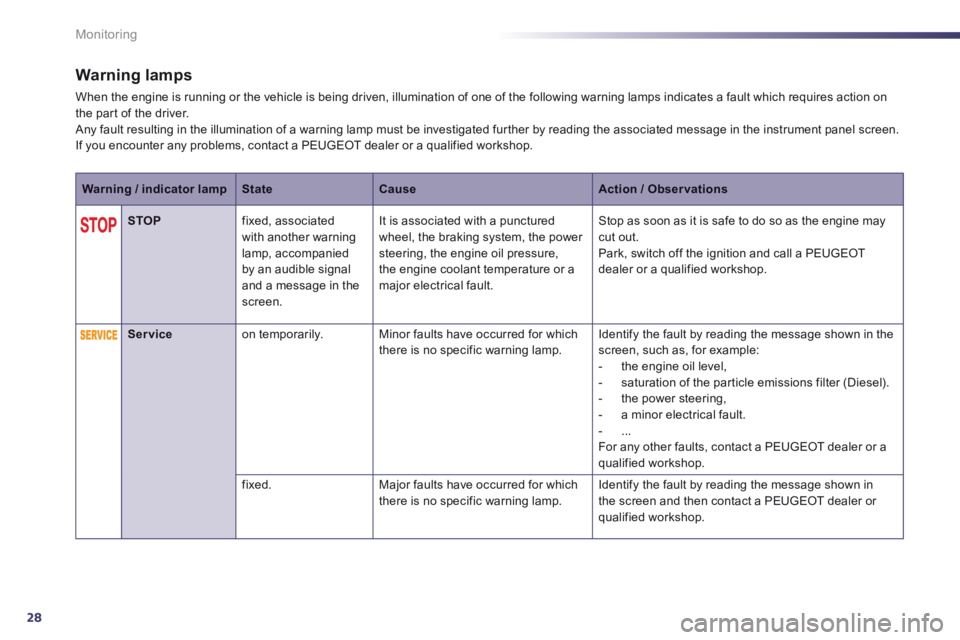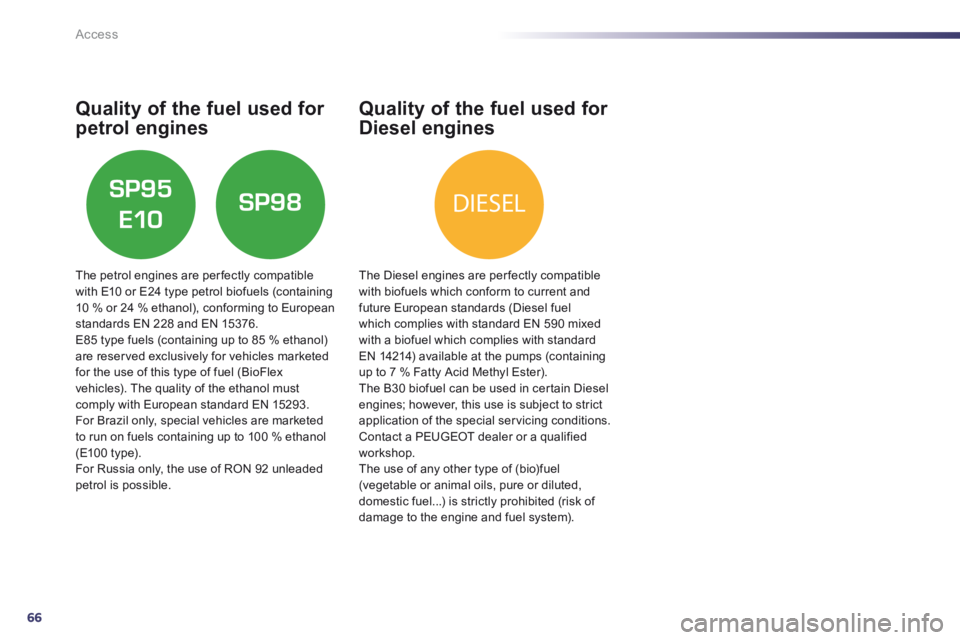Page 18 of 352
16
Familiarisation
Monitoring
On switching on, the dial needles go to the extent of their travel then return to 0. A. With the ignition on, the needle should indicate the fuel remaining. B. With the engine running, the associated low level warning lamp should go off.
Instrument panel
1. With the ignition on, the orange and red warning lamps come on. 2. With the engine running, these warning lamps should go off. If a warning lamp remains on, refer to the page concerned.
Warning lamps
23
C. With the ignition on, the instrument panel screen should indicate the level of oil. If the levels are not correct, top up the level which is low.
37
Page 23 of 352

.
21
Limit the causes of excess
consumption
Spread loads throughout the vehicle; place the heaviest items in the bottom of the boot, as close as possible to the rear seats. Limit the loads carried in the vehicle and reduce wind resistance (roof bars, roof rack, bicycle carrier, trailer...). Use a roof box in preference. Remove roof bars and roof racks after use.
At the end of winter, remove snow tyres and refit your summer tyres.
Observe the recommendations
on maintenance
Check the tyre pressures regularly, when cold, referring to the label in the door aperture, driver's side.
Carry out this check in particular: - before a long journey, - at each change of season, - after a long period out of use. Don't forget the spare wheel and the tyres on any trailer or caravan.
Have your vehicle serviced regularly (engine oil, oil filter, air filter...) and observe the schedule of operations recommended by the manufacturer.
When refuelling, do not continue after the third cut-off of the nozzle to avoid any over flow.
At the wheel of your new vehicle, it is only after the first 1 800 miles (3 000 kilometres) that you will see the fuel consumption settle down to a consistent average.
Page 24 of 352
22
Monitoring
Petrol-Diesel instrument panel
1. Rev counter (x 1 000 tr/min or rpm), graduation according to engine (petrol or Diesel). 2. Engine oil temperature gauge. 3. Fuel gauge. 4. Engine coolant temperature gauge. 5. Speedometer (mph or km/h). 6. Cruise control or speed limiter settings.
7. Gear shift indicator for a manual gearbox or gear lever position and gear for an electronic gear control or automatic gearbox.
A. Main lighting dimmer. B. Display of alert log. Recall of the service information. C. Reset the trip distance recorder.
8. Display zone: alert messages or state of functions, trip computer. 9. Trip distance recorder (miles or km). 10. Automatic wipers Service indicator (miles or km) then, total distance recorder. These two functions are displayed
successively when switching on the ignition.
Dials and screens Control buttons
Page 30 of 352

28
Monitoring
Warning lamps
When the engine is running or the vehicle is being driven, illumination of one of the following warning lamps indicates a fault which requires action on the part of the driver. Any fault resulting in the illumination of a warning lamp must be investigated further by reading the associated message in the instrument panel screen. If you encounter any problems, contact a PEUGEOT dealer or a qualified workshop.
Warning / indicator lampStateCauseAction / Observations
STOP fixed, associated with another warning lamp, accompanied by an audible signal and a message in the screen.
It is associated with a punctured wheel, the braking system, the power steering, the engine oil pressure, the engine coolant temperature or a major electrical fault.
Stop as soon as it is safe to do so as the engine may cut out. Park, switch off the ignition and call a PEUGEOT dealer or a qualified workshop.
Service on temporarily. Minor faults have occurred for which there is no specific warning lamp. Identify the fault by reading the message shown in the screen, such as, for example: - the engine oil level, - saturation of the particle emissions filter (Diesel). - the power steering, - a minor electrical fault. - ... For any other faults, contact a PEUGEOT dealer or a qualified workshop.
fixed. Major faults have occurred for which there is no specific warning lamp. Identify the fault by reading the message shown in the screen and then contact a PEUGEOT dealer or qualified workshop.
Page 33 of 352
1
31
Monitoring
Warning or indicator lamp in the instrument panel StateCauseAction / Observations
Engine oil pressure fixed. There is a fault with the engine lubrication system. You must stop as soon it is safe to do so. Park, switch off the ignition and contact a PEUGEOT dealer or a qualified workshop.
Battery charge fixed. The battery charging circuit has a fault (dirty or loose terminals, slack or cut alternator belt, ...).
The warning lamp should go off when the engine is started. If it does not go off, contact a PEUGEOT dealer or a qualified workshop.
Door(s) open fixed, associated with a message identifying the door, if the speed is below 6 mph (10 km/h).
A door or the boot is still open. Close the door or boot.
fixed, associated with a message identifying the door, and accompanied by an audible signal if the speed is above 6 mph (10 km/h).
Page 35 of 352

1
33
Monitoring
Coolant temperature gauge
With the engine running, when the needle is: - in zone A , the temperature is correct, - in zone B , the temperature is too high; the central STOP warning lamp comes on, accompanied by an audible signal and a message in the instrument panel screen. You MUST stop as soon as it is safe to do so. Wait a few minutes before switching off the engine. Contact a PEUGEOT dealer or a qualified workshop.
After driving for a few minutes, the temperature and pressure in the cooling system increase. To top up the level: wait for the engine to cool, unscrew the cap by two turns to allow the pressure to drop, when the pressure has dropped, remove the cap, top up the level to the "MA X" mark.
On switching on the ignition or when driving, it indicates the engine oil temperature. With the needle in zone C , the temperature is correct. With the needle in zone D , the temperature is too high. Slow down to lower the oil temperature.
Engine oil temperature
gauge
Be aware of the risk of burns when topping up the cooling system. Do not fill above the maximum level (indicated on the reservoir).
Page 39 of 352

1
37
Monitoring
Engine oil level indicator *
Oil level incorrect
This is indicated by the display of the message "Oil level incorrect" in the instrument panel screen, accompanied by the service warning lamp and an audible signal. If the low oil level is confirmed by a check using
the dipstick, the level must be topped up to avoid damage to the engine. Refer to the "Checking levels" section.
Oil level indicator fault
This is signalled by the display of the message "Oil level measurement invalid" in the instrument panel. Contact a PEUGEOT dealer or a qualified workshop.
In the event of a fault with the electric indicator, the oil level is no longer monitored. If the system is faulty, you must check the engine oil level using the manual dipstick located under the bonnet. Refer to the "Checking levels" section.
The total mileage is displayed in zone A of the screen and the trip mileage in zone B .
With the trip mileage displayed, press the button for a few seconds.
Mileage recorder
Trip recorder zero reset
On versions fitted with an electric oil level indicator, the state of the engine oil level is displayed in the instrument panel for a few seconds, after the servicing information.
The level read will only be correct if the vehicle is on level ground and the engine has been off for more than 30 minutes.
Oil level correct
* Depending on version.
Page 68 of 352

66
DIESEL
Access
Quality of the fuel used for
petrol engines
The petrol engines are per fectly compatible with E10 or E24 type petrol biofuels (containing 10 % or 24 % ethanol), conforming to European standards EN 228 and EN 15376. E85 type fuels (containing up to 85 % ethanol) are reserved exclusively for vehicles marketed for the use of this type of fuel (BioFlex vehicles). The quality of the ethanol must comply with European standard EN 15293. For Brazil only, special vehicles are marketed
to run on fuels containing up to 100 % ethanol (E100 type). For Russia only, the use of RON 92 unleaded petrol is possible.
Quality of the fuel used for
Diesel engines
The Diesel engines are per fectly compatible with biofuels which conform to current and future European standards (Diesel fuel which complies with standard EN 590 mixed with a biofuel which complies with standard EN 14214) available at the pumps (containing up to 7 % Fatty Acid Methyl Ester). The B30 biofuel can be used in certain Diesel engines; however, this use is subject to strict application of the special servicing conditions.
Contact a PEUGEOT dealer or a qualified workshop. The use of any other type of (bio)fuel (vegetable or animal oils, pure or diluted, domestic fuel...) is strictly prohibited (risk of damage to the engine and fuel system).